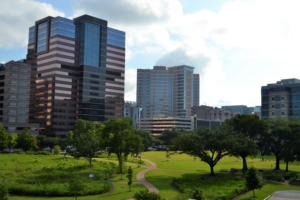Transforming Communities through Resilience
 The Federal Emergency Management Agency (FEMA)’s new pre-disaster mitigation program – Building Resilient Infrastructure and Communities (BRIC) – has the power to transform communities across the nation. Investing in resilience enables communities, states, tribes, and territories to increase preparedness for and mitigate the risks of natural disasters and other hazards. The historic amount of funding available through BRIC provides communities the opportunity to undertake complex infrastructure projects that will reduce their risk and increase resilience for years to come.
The Federal Emergency Management Agency (FEMA)’s new pre-disaster mitigation program – Building Resilient Infrastructure and Communities (BRIC) – has the power to transform communities across the nation. Investing in resilience enables communities, states, tribes, and territories to increase preparedness for and mitigate the risks of natural disasters and other hazards. The historic amount of funding available through BRIC provides communities the opportunity to undertake complex infrastructure projects that will reduce their risk and increase resilience for years to come.
A New Generation of Mitigation Funding
Communities across the country often lack the necessary funding and infrastructure to bolster their resiliency and build back stronger following a major disaster. BRIC provides enhanced federal funding to states, local communities, tribes, and territories to develop, fund, and build innovative mitigation projects.
BRIC is the first of its kind large scale, holistic pre-disaster mitigation fund from the federal government. Replacing FEMA’s Pre-Disaster Mitigation (PDM) grant program, BRIC provides a new proactive approach to disaster and risk management, shifting the focus from post-incident response to pre-incident mitigation. BRIC incentivizes communities to enhance their capacity to reduce the impact of disasters by building resilient infrastructure projects to increase resilience. The program also encourages states to work with local communities and the private sector to form partnerships to identify a community’s most-pressing needs and determine projects that would be most beneficial to build resilience at all levels.
BRIC’s focus on resiliency building through research-driven and proactive investment in communities aims to break the reactive disaster response cycle. Communities not historically impacted by natural disasters are now experiencing frequent and intense storms due to climate change and need resilient infrastructure to withstand them. Rather than focusing on individual disaster and recovery events, BRIC fosters collaboration at all levels to create a resilient nation. BRIC fosters stronger building codes and modern construction standards; better land use decisions; and close coordination among states/territories, tribes, and localities. The desired outcome will be lives saved and property protected.
BRIC’s Four Priorities
FEMA outlined BRIC’s four main priorities to build resiliency in communities:
- Strengthen public infrastructure: BRIC will support large-scale mitigation projects to invest in resilient infrastructure. Applicants may submit an unlimited number of mitigation project sub-applications each valued up to $50 million. This funding provides communities the opportunity to invest in efforts that will address critical needs and significantly reduce the risk of natural disasters. Proposed projects will be evaluated by their feasibility, effectiveness, planning, and ability to increase resilience.
- Prioritize mitigation of FEMA’s Community Lifelines: Lifelines ensure a community’s needs are met and enable all other functions to operate smoothly, especially in an emergency. When lifelines become disrupted due to a disaster, the effects of the incident can become magnified, increasing stress and disfunction. Communities should invest in their lifelines – e.g. safety and safety, food and shelter, health and medical, transportation, energy, communication, and hazardous material – to build resiliency and mitigate risk.
- Incorporate sustainable, nature-based solutions: The projects that BRIC will fund should strive to be sustainable for the long-term. Many nature-based solutions are available to provide cost-effective ways to reduce the risk of natural disasters and replace structural or ”grey” infrastructure.
- Update and enforce the adoption of building codes: Building codes are essential to ensure communities are prepared to withstand and mitigate hazards and disasters. Compliance with strong building codes has long-lasting impacts on a community’s risk reduction and reduces the cost to repair critical services and facilities following a disaster.
Your BRIC Application
BRIC’s funding will be highly competitive, making it vital that applicants review all requirements and information to submit a strong proposal and increase the likelihood of receiving funding.
The benefit-cost analysis (BCA) is a critical part of the mitigation project application process. BCA is a method to assess the desirability of government projects when their benefits and costs to society occur in different time periods. Applicants can use FEMA’s BCA tool to obtain an analysis and confirm the benefit-cost ratio (BCR) is of 1.0 or greater. These metrics are important to indicate the project will meet BRIC’s objective to reduce risk and potential losses in excess of the cost of mitigation.
The projects that may receive a higher score or have a greater chance of being funded will innovatively address FEMA’s priorities and create resilience to withstand future disasters and risks. In addition, a BRIC application where a community provides a strong public and private partnership to achieve resilience may more likely be favored.
IEM’s mission is to create safe, secure and resilient communities. Our mitigation team can help you build a strong, innovative BRIC application. We know what works and how to proactively invest in resilience. Contact one of our experts today.




